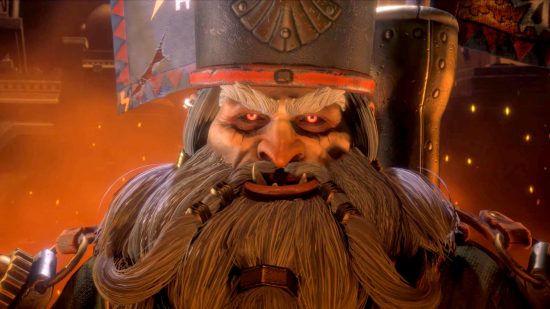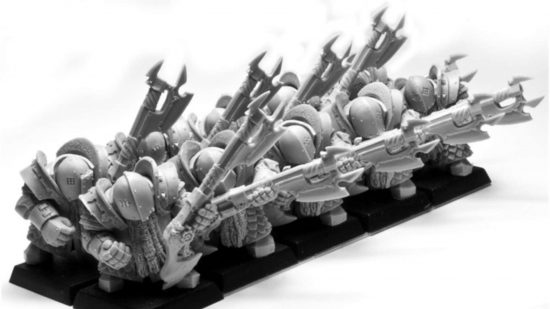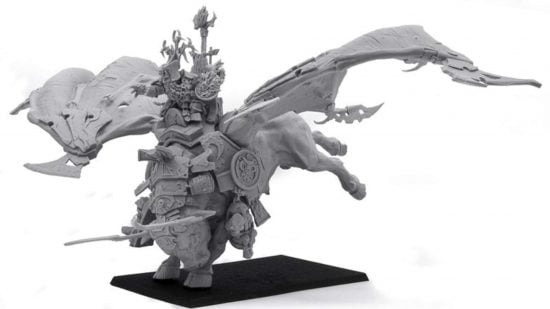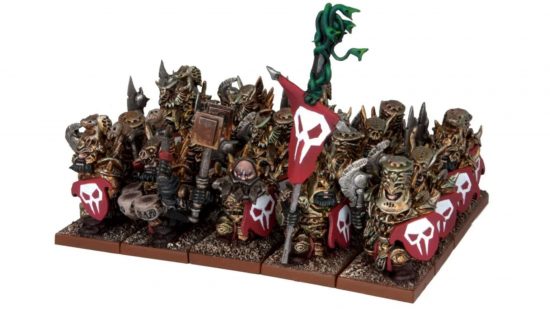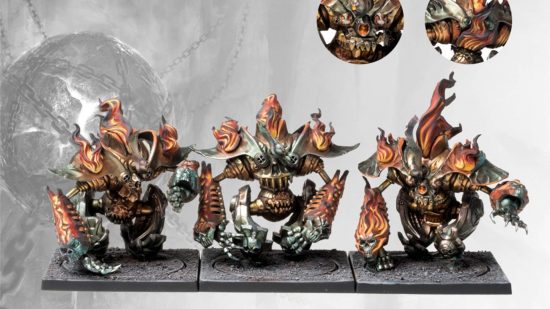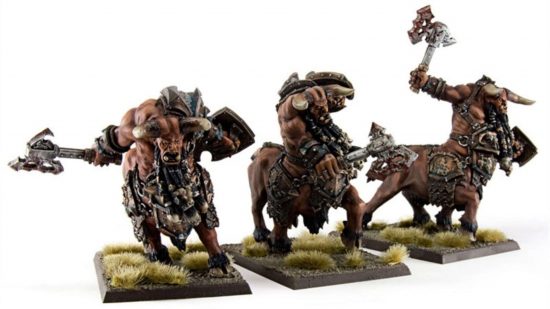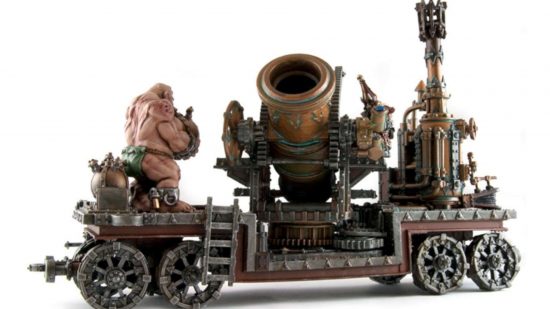The Warhammer Chaos Dwarfs are a race of sadistic slavers pledged to the Chaos god Hashut. They dwell in factory cities in the Dark Lands to the East of the Old World, where forges glow with infernal industry, and untold thousands of slaves toil to craft their malignant machines of war.
If these short and spiteful villains prove not to be your cup of sulfurous tea, we’ve got more guides to the Warhammer: The Old World factions you can check out. We’ve also got guides to The Old World rules, and a particular breakout on the Old World combat phase.
Here’s everything you need to know to get started with Warhammer Chaos Dwarfs:
- Chaos Dwarfs lore
- Chaos Dwarf models
- How to play Chaos Dwarfs
Chaos Dwarfs lore
Chaos Dwarfs lore starts with them as a spiteful offshoot of the Warhammer Dwarf faction. Long ago, while the Dwarfs first carved their holds into the roots of the World’s Edge Mountains, a group of Dwarfen explorers ventured ever further north and east, into the inhospitable Dark Lands. Gradually, they became estranged from their kin in the central lands.
When the Cataclysm of Chaos first wracked the Old World, it was all the Dwarf holds could do to shore themselves up in their mountains and pray to the ancestor gods for salvation. All contact with the kin in the Dark Lands was lost. But these silent holds did not perish.
The entity Hashut – a lesser chaos god – offered the Dwarfs his patronage. Believing themselves abandoned by their ancestor spirits, and with little hope to survive the assault of Chaos, the Dwarfs readily pledged to his service. Thus did they become the Sons of Hashut, and he their Dark Father.

Chief among Hashut’s gifts to the Chaos Dwarfs was the rare gift of sorcery. While other Dwarfs have the skill to bind the winds of magic into powerful runic artefacts, Hashut’s Sorcerers are able to wield raw magic itself. Yet there is a terrible price to pay for this power, for every one of these sorcerers is doomed to gradually petrify, becoming a solid stone statue.
The Chaos Dwarf Empire is sustained by slavery. Chief among these slaves are the numberless greenskins of the Orc and Goblin tribes. It was by the magic of the Chaos Dwarfs that the first Black Orcs were created, in an effort to create a more obedient and intelligent slave race – an attempt that backfired spectacularly, as the Black Orc rebellion almost annihilated the Chaos Dwarf masters.
Chaos Dwarfs are accompanied to war by all manner of monsters, from the mutant Bull Centaurs, to the mighty winged Taurus, and blazing K’daai Fireborn. Yet they are most feared for their devastating war engines, great iron beasts born of hellish industry and devilish sorcery that devastate their foes with grinding wheels, belching fire, and truly massive explosives.
Chaos Dwarf models
Currently, Games Workshop doesn’t sell a range of Chaos Dwarf models. One might be in development: there are heavy narrative hints in Age of Sigmar that the Orruk Kruleboyz are trading slaves to a race of Chaos Dwarfs, so models could be on the way before too long.
Some parts of the AoS and Old World range can be used for parts of the Chaos Dwarf army. Black Orcs can be represented either by Orruk Ardboyz or the re-released Old World Black Orc kit. Hobgoblin Sneaky Gits are well represented by Hobgrot Slittaz. And the Chaos Dwarf Hellcannon, which will be rereleased for the Chaos Warriors army, can be taken in the Chaos Dwarfs army.
Mantic Games’ Abyssal Dwarfs line from Kings of War is a solid starting point for Chaos Dwarf infantry, with affordable plastic kits that can represent your Infernal Guard without any hassle. It features some solid character models too.
The Abyssal Halfbreeds from the Mantic range may suffice as Bull Centaurs in a pinch, but they’re a bit small. However, the Ratkin Death Engine will make good conversion stock for an Iron Daemon.
While most of the models from Conquest: Last Argument of Kings are too large to sit alongside 28mm scale minis, the Dweghom Inferno Automata will work brilliantly as K’dai Fireborn.
For resin miniatures, MoM Miniatures Dark Dwarfs range is small, but the infantry are very nice. Scibor miniatures has an impressive range of chaotic dwarfs, called the Moscals, which includes a very nice Taurus-riding lord and some Bull Centaurs.
Your options open up substantially if you have a 3D printer. Lost Kingdom Miniatures makes an amazing range of STLs for Infernal Dwarfs, including big models like Lammasu, Bull Centaurs, and war engines, all with a distinctive Babylonian aesthetic. Meanwhile, Empire Miniatures has a good range of evil dwarf infantry.
How to play Chaos Dwarfs
It can be tricky working out how to play Chaos Dwarfs because the army is so different from anything else. Like the Dwarfen Mountain Holds, your core troops are slow-moving and very hard to kill. You’re similarly supported by a range of devastating war engines. But that’s where the similarities end.
Chaos Dwarfs are more elite than their traditionalist kin, with the ‘basic’ Infernal Guard stronger than Dwarf Warriors. Their ranged weapons are powerful, but also more expensive than handguns and crossbows. To prevent your forces becoming totally outmaneuvered, you need to disrupt the enemy’s plan using three tools that the hidebound Dwarfen Mountain Holds lack: disposable levies, powerful cavalry and heavy chariots, and sneaky tricks.
Similar to the Gnoblars in the Ogre Kingdoms and Men at Arms of Bretonnia, Hobgoblin Cutthroats exist to fill space in your battleline and protect your more important units’ flanks. They’re cheap as dirt, fragile, and badly disciplined; but as levies no-one in your army will care when they break and flee.
Bull Centaurs and Iron Daemons both have devastating charges, with multiple attacks and multiple impact hits. They’re not the fastest cavalry or chariots in the game, but they’re durable – particularly the Iron Daemon, which is effectively a chaotic Steam Tank. Against slower armies they’ll be able to alpha strike, while against faster foes you may need to reserve them to act as the hammer to your Infernal Guard anvil.
Hobgoblin Wolf Riders armed with bows, upgraded with the reserve move ability to reposition after shooting, make extremely effective lone character and artillery hunters. Similarly, ambushing Sneaky Gits can enter your opponent’s backfield and start by throwing knives into enemy ranged units before rear charging next turn.
The backstab ability shared by all Hobgoblins – which grants rerolls to hit when engaging an enemy flank or rear – give these units extra bite when they join combat.
The Dreadquake Mortar, as well as causing damage, unleashes a mini earthquake around the point where it lands, which reduces unit movement and strips units of the Swiftstride ability. Though this is a very pricey war machine – and may struggle to fire in multiple turns, unless upgraded with an Ogre loader – it’s an amazing tool for hobbling enemy cavalry and monsters.
Speaking of monsters, Chaos Dwarfs have a selection of winged mounts, from the monstrous Lammasu to the behemoth Bale Taurus. While their application with combat characters is obvious, these make great delivery systems for your spell casters.
Sorcerer-Prophets are less vulnerable in melee than most wizards, with WS5, T5, and the ability to wear armor. You can confidently unleash the Storm of Ash, a signature spell from the lore of Hashut which generates a 9” aura of -1 to hit for enemy attacks, and then charge them into enemy lines where it will cause maximum disruption.
If you want to get shooting and spell-slinging with the Chaos Dwarfs right away, and know that painting miniatures for an army will take a long guide, check our guide to Total War: Warhammer III DLC to find out how to add them to the ultimate Warhammer fantasy game.
